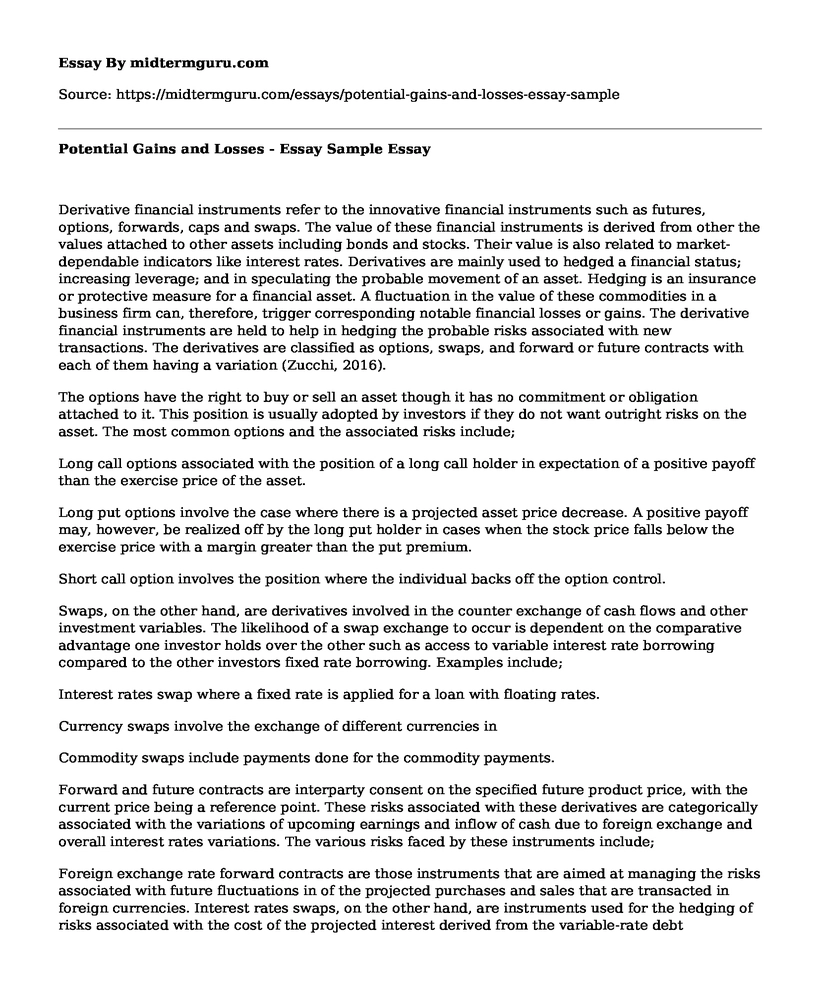Derivative financial instruments refer to the innovative financial instruments such as futures, options, forwards, caps and swaps. The value of these financial instruments is derived from other the values attached to other assets including bonds and stocks. Their value is also related to market-dependable indicators like interest rates. Derivatives are mainly used to hedged a financial status; increasing leverage; and in speculating the probable movement of an asset. Hedging is an insurance or protective measure for a financial asset. A fluctuation in the value of these commodities in a business firm can, therefore, trigger corresponding notable financial losses or gains. The derivative financial instruments are held to help in hedging the probable risks associated with new transactions. The derivatives are classified as options, swaps, and forward or future contracts with each of them having a variation (Zucchi, 2016).
The options have the right to buy or sell an asset though it has no commitment or obligation attached to it. This position is usually adopted by investors if they do not want outright risks on the asset. The most common options and the associated risks include;
Long call options associated with the position of a long call holder in expectation of a positive payoff than the exercise price of the asset.
Long put options involve the case where there is a projected asset price decrease. A positive payoff may, however, be realized off by the long put holder in cases when the stock price falls below the exercise price with a margin greater than the put premium.
Short call option involves the position where the individual backs off the option control.
Swaps, on the other hand, are derivatives involved in the counter exchange of cash flows and other investment variables. The likelihood of a swap exchange to occur is dependent on the comparative advantage one investor holds over the other such as access to variable interest rate borrowing compared to the other investors fixed rate borrowing. Examples include;
Interest rates swap where a fixed rate is applied for a loan with floating rates.
Currency swaps involve the exchange of different currencies in
Commodity swaps include payments done for the commodity payments.
Forward and future contracts are interparty consent on the specified future product price, with the current price being a reference point. These risks associated with these derivatives are categorically associated with the variations of upcoming earnings and inflow of cash due to foreign exchange and overall interest rates variations. The various risks faced by these instruments include;
Foreign exchange rate forward contracts are those instruments that are aimed at managing the risks associated with future fluctuations in of the projected purchases and sales that are transacted in foreign currencies. Interest rates swaps, on the other hand, are instruments used for the hedging of risks associated with the cost of the projected interest derived from the variable-rate debt commitments and help gain a fixed rate of net interest ("NOTE 14. DERIVATIVE FINANCIAL INSTRUMENTS AND RISK MANAGEMENT for FMC_Technologies (FTI)", 2016).
Derivative Valuation
The valuation of derivatives is based upon future cash flows, the prevailing current value of the projected cash flows and model used to evaluate the derivatives. Simple binomial model method involves step by step evaluation of option prices. Black-Scholes Method is an analytical step by step solution with more computational efficiency and is used in the demonstration of a risk of the power of a neutral pricing. The model assumes that the returns on the asset are evenly distributed. Stock price model assumes that the stock price as the geometric Brownian motion where a change in stock price equals a constant return on stock and the Weiner process (Davis, 2010). The major shortcoming of all these models are the assumptions made that may not hold always as projected.
References
NOTE 14. DERIVATIVE FINANCIAL INSTRUMENTS AND RISK MANAGEMENT for FMC_Technologies (FTI). (2016). Wikinvest.com. Retrieved 29 October 2016, from http://www.wikinvest.com/stock/FMC_Technologies_(FTI)/Derivative%20Financial%20InstrumInst%20Risk%20Management
Zucchi, K. (2016). Derivatives 101. Investopedia. Retrieved 29 October 2016, from http://www.investopedia.com/articles/optioninvestor/10/derivatives-101.asp
Davis, M. (2010). Model-Free Methods in Valuation and Hedging of Derivative Securities. SSRN Electronic Journal. http://dx.doi.org/10.2139/ssrn.2593587
Cite this page
Potential Gains and Losses - Essay Sample. (2021, May 24). Retrieved from https://midtermguru.com/essays/potential-gains-and-losses-essay-sample
If you are the original author of this essay and no longer wish to have it published on the midtermguru.com website, please click below to request its removal:
- Essay on Electronic Resource Planning in Volkswagen
- Essay on Tensions Between Creativity and Power
- Challenges to Organizational Change - Essay Sample
- Planning and Allocation of Work - Paper Example
- Stakeholders Management and Corporate Performance Essay
- Interview Example on a Leader and Teacher
- How Has the Role of the Strategic Planner Changed Over the Past Few Decades? - Essay Sample







